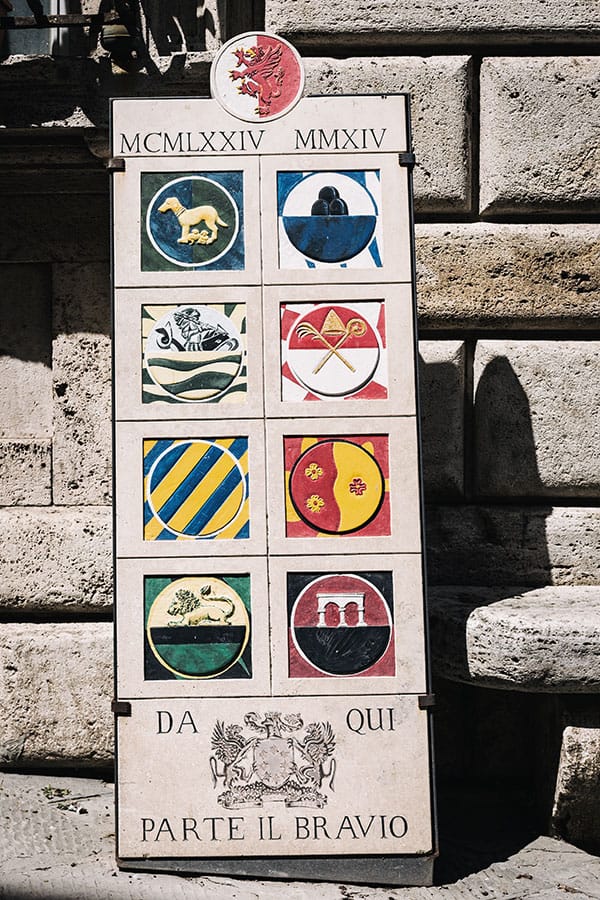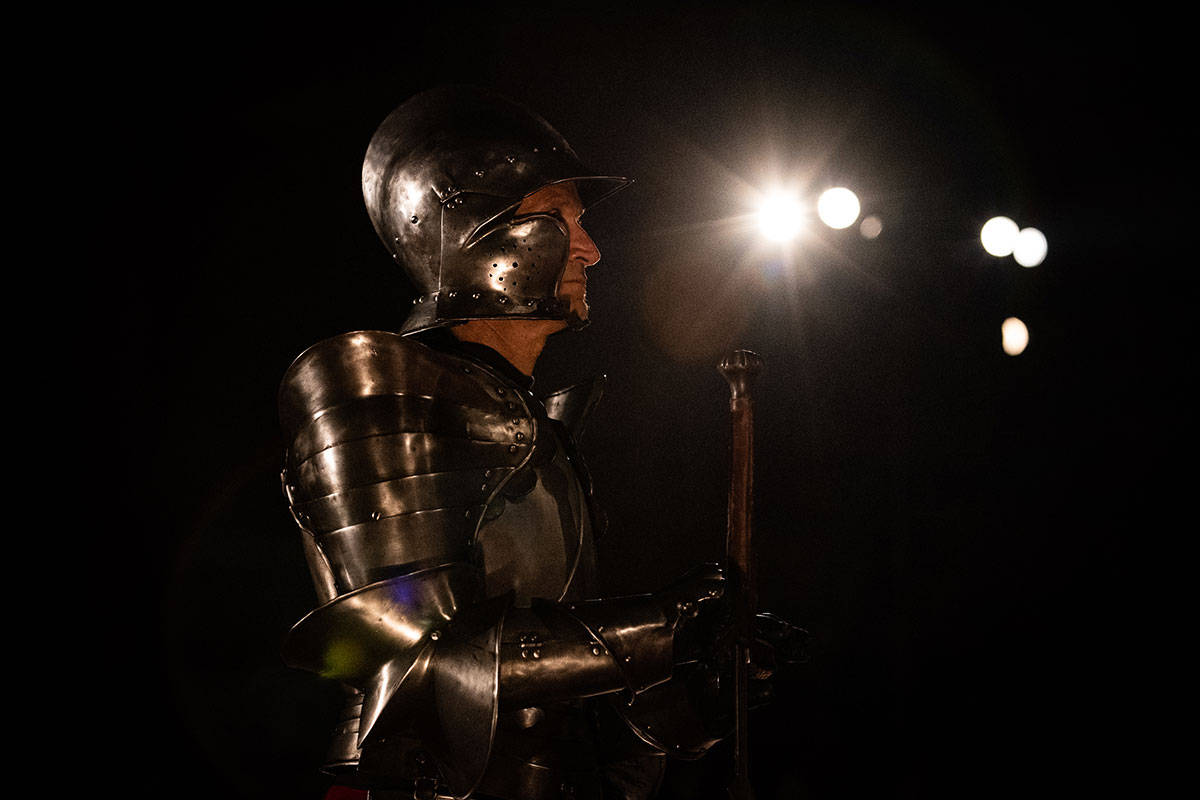
Every year, on the last Sunday of August, Montepulciano is animated by the so called “Bravìo delle Botti”, a traditional barrel race between the eight districts of the town now replacing its medieval form: a conventional horse race.
Each barrel, weighing about 80 kg, is pushed by two athletes – known as “pushers” – along the winding uphill path that develops through the picturesque streets of Montepulciano’s historical center for about 1.8 km, up to the Cathedral square in “Piazza Grande” which represents the finish line.
The race is traditionally preceded by a fascinating historical parade, characterized by the presence of more than three hundred locals. Our proud fellow citizens, dressed up with historical costumes, parade along the same route throwing flags, playing medieval drums and evoking striking images of ancient times.
The word “Bravìo” comes from the vulgar “Bravium” and indicates the prize awarded to the winning district. The painted cloth bears the iconographic image of the patron saint of Montepulciano, St. John the Beheaded, in honor of which the event is held every year.
The history of Montepulciano’s districts can be traced back to the late fourteenth century, more precisely in 1373 AD. During that year, the City Charter devoted an entire chapter to the race provisions – a horse race which appears to be set up precisely with that law.
The competition was conceived in honor of the patron saint of Montepulciano, celebrated on August 29th, “to perpetual and happy memory of the citizens”. The Bravìo was ran with horses until the seventeenth century, when it was eventually suppressed for reasons of public order.
I terzieri
The districts, each of which had both supervising and administrative roles, are described in the municipal charter of 1373 AD – more precisely in the fourth book of the Mayor – and have maintained their very names up to present times: Cagnano, Collazzi, Coste, Gracciano, Poggiolo, San Donato, Talosa and Voltaia. Since their foundation, the districts are grouped into three “terzieri” – where “terziere” means one of three parts in which a city is divided.
S. Maria: white; mystic rose emblem; made up of the districts of Cagnano, Collazzi and San Donato.
St. Francis: Green; thistle crest; made up of the districts of Coste, Talosa, Voltaia.
St. Augustine: red; miter and pastoral crest; made up of the districts of Gracciano, Poggiolo.
The "Societas"
Each district had its own “Societas” whose head was called “Rector”. Every Rector administered within certain limits the district business and represented it in particular occasions such St. John’s celebrations, held on every August 29th. On that day, they had to go to the church of “Santa Maria” – approximately where the cathedral stands today – with at least ten men whose job was that of offering a 15-pound candle to the saint (opposed to the 10-pound ones given by Collazzi and Le Coste, the poorest districts).
On the day of St. Agnes’ celebrations, on May 1st, they also had to take part in the holy function taking place in the monastery of “Santa Maria Novella”, just outside Gracciano’s entrance to the town. There, in the nowadays church of St. Agnes, they again had to offer adequately sized candle to the Saint.
On these two important festivities, particularly important was the participation of commoners together with the “deployment” of the entire municipal leadership: the “Gonfaloniere”, the numerous notaries, the Mayor with his Councilors, the “Potestà” and the Judge, stranger officers and the garrisons of the cities.
Having a glance at Montepulciano’s districts history not only helps us to get an idea of what life in this town was like at the time, but it also allows us to observe its urban structure and the transformations that occurred between 1200 and 1300 AD. It is now strongly believed that the oldest districts are those of the “Sasso” area, the highest part of the city, which is where the first-born districts – namely San Donato, Talosa and most likely Poggiolo – are still located.
The most recent districts – Collazzi, Le Coste, Cagnano, Voltaia and Gracciano – were originally considered “villages” (i.e. urban agglomerations located outside the city walls), until 1281 and only became proper districts around 1300. From the ancient history of the Contrade of Montepulciano, as documented in the Municipal Charters of the time, we can observe that nomenclature, colors, badges, urban position and ceremonial model have been maintained exactly as they were, without any variation.

The recent history of the “Bravìo” began in 1974 when a parish priest, Don Marcello del Balio, had the idea to transform the ancient horse race into a barrel race.
His intuition, whilst absolutely brilliant, couldn’t be more appropriate, given the international reputation and the quality of the “Vino Nobile” for which Montepulciano is famous worldwide. The barrels are indeed a vital element for the economy of Montepulciano, as they are fundamental to the aging process of the wine.
The “Bravìo” is held on every last Sunday of August. Starting from 10 am in “Piazza Grande”, a series of impressive traditional ceremonies are hosted: the starting order of the barrels during the race is extracted by lot, followed by the typical “branding” of their wood; the districts unwind their flags, unavoidably accompanied by the solemn rhythm of drums; the Mayor delivers the cloth to the head of the “Magistrato of the Contrade”, an official handover that precedes the offer of votive candles to St. John in the Cathedral. In the afternoon, at 3 pm, the parade begins with its fascinating historical procession.
Finally, at 7 pm, after the signal given by the ringing of the City Hall bells, the barrels start rolling from the “Colonna del Marzocco”. After a few minutes the “Bravìo” is over; only one district can now celebrate the victory taking home the longed cloth. The other districts are already thinking about their future victories, without resentment or hostility of any kind, showing respect for the winner; a story that has been going on for over six hundred years.
The week preceding the “Bravìo” is full of traditional events, such as the “Proclama del Gonfaloniere” and the “Corteo dei Ceri”. Every evening the districts are open to everyone, ready to welcome both locals and foreigners with parties, typical Tuscan dinners, games, music and obviously some excellent wine.
Heritage of Italy
In 2011, the “Bravìo delle Botti” of Montepulciano was nominated by the Italian Ministry of Tourism “an event of cultural importance worthy of attention”. The Minister, in a letter addressed directly to the “Magistrato delle Contrade”, has included the “Bravìo” among the events that contribute to the promotion of both history and tradition, emphasizing its artistic, cultural and historical heritage which make it a significant driving force for the Italian touristic economy.

Thanks to its ability of keeping the folklore of this territory alive, the “Bravìo” was inserted into a ministerial project and is nowadays considered an event able to maintain traditional costumes whilst adapting to contemporary times “turning them into tourist attractors, able to record a wider and growing participation”.
Thanks to the original idea of Don Marcello and to the progress and improvements made over the recent years, we are now facing a moment of peculiar attention and interest for the event. Nevertheless, the “Bravìo” world is well aware of its origins and its primary nature: that of collective and social participation on which an entire community is proudly based.


